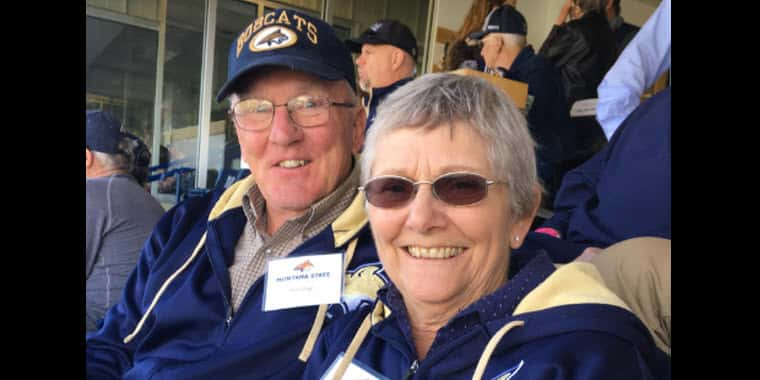by Jenny Lavey, MSU News Service
BOZEMAN – Thanks to a serendipitous conversation on the Hi-Line, cattle research at Montana State University has received a large boost with the purchase of a red Angus purebred cattle herd.
MSU is the new owner of 51 head of cattle, which the university bought from MSU alumni Bob and Rita
“Owning the herd is a tremendous opportunity for MSU and Montana,” Boss said. “The purchase will enable MSU to conduct research on various issues such as heifer development, lifetime productivity,
After raising red Angus cattle for the better part of 25 years with their now-grown three daughters, the Diges were making plans to retire from their red Angus operation last summer. They said they were unsure what they would do with the herd upon retirement.
“We knew we wanted to keep the herd together so that we wouldn’t have to piecemeal them out as individual sales,” Bob said. “We also wanted to sell to someone who would appreciate their genetic lineage over the years.”
The Diges visited MSU’s NARC facility at Fort Assiniboine near Havre in September 2015 for a red Angus field day tour sponsored by the Montana Red Angus Association. Boss mentioned to the Diges that several MSU faculty were actively searching for and hoping to purchase purebred red Angus cattle for a variety of livestock research projects.
“It was one of those moments where this fell into our lap, and we knew it would be a perfect match,” Rita said. “Our cows would be going someplace where they would be taken care of, and MSU could use them for the benefits of students and research.”
In October, MSU purchased the herd from the Diges for market value, in part by using sales income from the university’s existing black Angus herd. The red Angus herd is now living at the Bozeman Agricultural Teaching and Research Farm, which the Department of Animal and Range Sciences in the College of Agriculture manages.
MSU Extension Beef Cattle Specialist Rachel
That might be because of the meticulous and detailed genetic recordkeeping related to the herd; the Diges gave MSU a record book that includes breeding stock specifics and notes down to the individual cow, Endecott said.
“The level of recordkeeping is remarkable, even for a registered herd,” Endecott said.
The recordkeeping was so detailed, Endecott added, that the Diges even
“By knowing the pedigree relationships and genetic background of the cattle, it will allow MSU to examine the genetic basis of relevant performance and production traits,” Boss said. “The recordkeeping breeding of the herd provides a critical springboard for genetics and genomics research.”
Thomson, who studies the physiology and biology of economically important traits in livestock breeding and genetics, said the Diges’ recordkeeping will allow MSU to build on the herd’s genetic evaluation and improve predictions of cattle genetic merit that are applicable to the beef industry.
“Our goal as researchers is to identify regions of the genome that harbor genes and variants related to specific traits that are economically relevant to the industry like growth, weaning weight, milk
Well-known for their highly desirable traits such as mothering ability, carcass
Endecott said that although many Montana ranchers raise black Angus cattle, the applied research that will come from the red Angus herd has major economic impact for all Montana livestock producers. And, in an effort to investigate inherited bovine traits, she said some of the red Angus cattle will be bred with the university’s existing black Angus cattle.
“As a university, we’re well-positioned to take some risks associated with breeding for traits that producers may not be willing to risk,” she said. “With an entire purebred red Angus herd, we can investigate
Boss said the herd should instigate additional university-wide beef cattle research in livestock nutrition, supplementation, range efficiency and breeding.
“It’s quite a legacy the Diges are making to the future students of Montana State University and the beef cattle industry of Montana,” he said. “We’re all every excited about it.”
The Diges – who visited the herd when they were in town for a football game last fall – said they miss the cattle but are pleased with how the arrangement with MSU worked out.
“We’re fond of them, of course, but we know they’re in great hands,” Rita said. “Our cows went to college and now we’re looking forward to and excited about getting on with the next phase of our life.”


